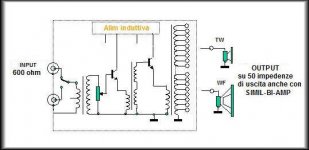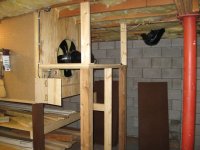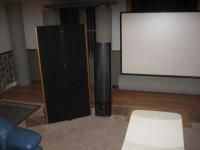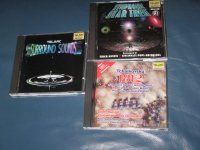Out of interest, does anyone understand how you can make an amplifier with no active components, driven only by transformers? That's the claim here:
AMPLIFICATORE VERO - ROYAL DEVICE Hi-Efficiency Loudspeakers Audiophile speaker systems High fidelity systems Sistemi di altoparlanti hi-end HiFi ed Alta Efficienza Lautsprecher Diffusori acustici stereo Enceintes acoustiques
This isn't a power amplifier but a pre-amplifier with voltage gain. Basiclly the same than MC/MM transformer. The higer the voltage gain, the higher the output resistance.
check out this threads for such parts:
http://www.diyaudio.com/forums/tube...mers-attenuators-volume-control-overview.html
http://www.diyaudio.com/forums/anal...passive-preamplifier-transformer-section.html
I see transistors. from the big transformer on the right, just down and left. At least 3 there...
You are right. And this is clearly an actice preamp, but without voltage gain by the transistors for coil driving (two emitter follower's are driving transformer coils) I have only transformers discovered by first look - sorry.
Attachments
What, you don't have any equipment to accelerate the light moving through your S/PDIF interconnects, thus having it travel through time in a specialized pocket dimension at the center of a power triangle (where the quantum shift happens,) which enable playback of the original sounds before any distortion could be added by the recording process?
Clearly, this is the big news.
I got to get me one of them.
Clearly, this is the big news.
I got to get me one of them.
You'll have to come back yesterday,they're on back-order.
He only states that no active components are used for voltage gain. Apparently the transistors are used for current "gain". So, take a line level signal in, produce a high-current line-level output (voltage gain = 1, essentially a high-current voltage buffer), then step up the voltage with transformers (voltage gain = x, current gain = 1/x). Kind of the opposite of a tube amp, where you have very high voltage gain but low current, then step down with a transformer.
I asume, there are additional devices therefore in the detailled circuit diagram (couple caps for ac coupling and additional introducing of separate biasing network). Unfortunately I can't find it online. I don't know if this kind of topology is one of the royal way's but for me an interesting approach, especially for certainly power amps and very high efficiency speaker models. I recall, that I have see anywhere in one of the MJ magazines a similar topology - unfortunately I don't know the year and number of edition. I will look about various URL's there, if I have time: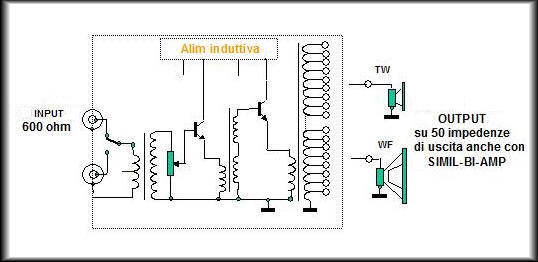
Wonder how he does the biasing..
http://www.diyaudio.com/forums/soli...sen-jikken-yearly-index-1924-2009-wanted.html
Last edited:
@ tiefbassuebertr
And what would you do with two pd.2450 ??? ;-)
Any good ideas?
thanks
Something like this.
@ lattensepp. I would not change that Subwooferconcept that you have. I do know it from the German Hifi Forum, and followed the whole story very interested.
The only thing I would personally change is the amplifying. I would try to get an old MarkLevinson ML-3 for example, or a pair of Bryston 7 B MonoAmps, a Crown MacroReference or other amps from that size to drive the Subs. I am sure the performance with the RCM Ampmodules is okay,no question. But I think the Drivers are worth to use something that is able to drive them to their maximum possible Performance. I dont talk about the maximum possible SPL,that is surely awesome, even with the RCM. Two PD 2450 in a living Room, that is close to a wreckingball. I do talk about control, impulseresponse, precision and the power. These PDs are some of the finest Woofers you could buy on the market today, so give them what they do need to perform at their best!
Greets from Germany
SpeakerFrank
The only thing I would personally change is the amplifying. I would try to get an old MarkLevinson ML-3 for example, or a pair of Bryston 7 B MonoAmps, a Crown MacroReference or other amps from that size to drive the Subs. I am sure the performance with the RCM Ampmodules is okay,no question. But I think the Drivers are worth to use something that is able to drive them to their maximum possible Performance. I dont talk about the maximum possible SPL,that is surely awesome, even with the RCM. Two PD 2450 in a living Room, that is close to a wreckingball. I do talk about control, impulseresponse, precision and the power. These PDs are some of the finest Woofers you could buy on the market today, so give them what they do need to perform at their best!
Greets from Germany
SpeakerFrank
The biggest Sub on Earth
This is impressive:
MTX Europe - MTX T9922-22 : The biggest sub on earth
aren't there car systems that go lower now?
This is impressive:
MTX Europe - MTX T9922-22 : The biggest sub on earth
More impressive than Kobayashi's horn ??
go to the images by post #6 about
http://www.diyaudio.com/forums/plan...100-kg-ale-goto-most-expensiv-over-world.html
@tiefbassuebertr
I do know the Goto Mid and Highrange Drivers and also Horns. They are really good,no question, but they are also overrated and overpriced for their performance. When you look at the prices for that stuff in Japan and then convert, add the transport and the taxes you get to a price from more then 100.000 EU for one ALE Driver/Horn combination!
One of the A160 Bassdrivers is around 33.000.- Euro, the other version the P160 wil be around 66.000.- Euro and the matching Bass-Horn is around 39.500.- Euro. And that are the prices without transport and the taxes in Germany. Ask youself if they could be worth that enourmous amount of money, only for ONE basshorn with driver!
@ ODougbo
Yes its huge, its heavy, its expensive, it looks impressive! Its the biggest inCar Hairdryer you could buy!
To be honest, its a totally stupid,useless Boomm-Roaarr Car-Audio nonsense!
Its not a personal offence to you ODougbo, I dont have that in mind.
Greets
SpeakerFrank
I do know the Goto Mid and Highrange Drivers and also Horns. They are really good,no question, but they are also overrated and overpriced for their performance. When you look at the prices for that stuff in Japan and then convert, add the transport and the taxes you get to a price from more then 100.000 EU for one ALE Driver/Horn combination!
One of the A160 Bassdrivers is around 33.000.- Euro, the other version the P160 wil be around 66.000.- Euro and the matching Bass-Horn is around 39.500.- Euro. And that are the prices without transport and the taxes in Germany. Ask youself if they could be worth that enourmous amount of money, only for ONE basshorn with driver!
@ ODougbo
Yes its huge, its heavy, its expensive, it looks impressive! Its the biggest inCar Hairdryer you could buy!
To be honest, its a totally stupid,useless Boomm-Roaarr Car-Audio nonsense!
Its not a personal offence to you ODougbo, I dont have that in mind.
Greets
SpeakerFrank
The more I read around this royal device site, the less impressed I am. Full of snake-oil and ridiculous claims of grandeur, reminiscent of the Affordable Valve nutter. My favourite (other than the quantum accelerator) has to be the SUPER EPIGENETIC internal cabling and external connection.
Out of interest, does anyone understand how you can make an amplifier with no active components, driven only by transformers? That's the claim here:
AMPLIFICATORE VERO - ROYAL DEVICE Hi-Efficiency Loudspeakers Audiophile speaker systems High fidelity systems Sistemi di altoparlanti hi-end HiFi ed Alta Efficienza Lautsprecher Diffusori acustici stereo Enceintes acoustiques
Yes, I've naively thought about it myself: a transformer takes voltage and steps it up or down, have 4 "coils" and 12v on one side of the transformer and 16 "coils" on the other side and you'll get 48v out out it-pretty simple and what is used in high voltage speaker systems for PA equipment
For most user's this is an enourmous amount of money, for few other only a pocket money (have a look also to some watches).@tiefbassuebertr
I do know the Goto Mid and Highrange Drivers and also Horns. They are really good,no question, but they are also overrated and overpriced for their performance. When you look at the prices for that stuff in Japan and then convert, add the transport and the taxes you get to a price from more then 100.000 EU for one ALE Driver/Horn combination!
One of the A160 Bassdrivers is around 33.000.- Euro, the other version the P160 wil be around 66.000.- Euro and the matching Bass-Horn is around 39.500.- Euro. And that are the prices without transport and the taxes in Germany. Ask youself if they could be worth that enourmous amount of money, only for ONE basshorn with driver!
Greets
- SpeakerFrank
The actually question must be follow: who can demonstrate the acoustical performace of those ALE driver's ? As far as I know, no one.
Nobody is spending money without knowing the result beforehand. And certainly not in that priceclass.
Thus not the costs are the problem, but the fact, that no one these parts has in stock.
Benefit to rotary subwoofer
I have had a Rotary subwoofer for over 3 years and its the most realistic
subwoofer that I have ever heard. Having response down to below 1 hz
is amazing and results in awesome fidelity. Pipe organ music with 8 and
16 hz stops is so very real sounding, and electronic music as well. Movies
have many sound effects below 20 hz and some as low as 3 hz! Transient
response is fabulous (produces a near perfect 2 hz square wave). When
adjusted for proper level (I use about 1/3 rd its capabilities) and balancing
with my Tympani IV bass panels provides a believable sound and is also very low in distortion.
The unspoken benefit of the rotary subwoofer is that for its output, it literally sips power. They can pound all-day-long at maximum output and never suffer power compression. One of these in a building is ridiculous. Two, mounted to the end of a 55 foot shipping container, could be considered a weapon of some sort. Only caveat, it's good up to around 40 Hz, so you'd still need some kit to match it up to the tops.
I have had a Rotary subwoofer for over 3 years and its the most realistic
subwoofer that I have ever heard. Having response down to below 1 hz
is amazing and results in awesome fidelity. Pipe organ music with 8 and
16 hz stops is so very real sounding, and electronic music as well. Movies
have many sound effects below 20 hz and some as low as 3 hz! Transient
response is fabulous (produces a near perfect 2 hz square wave). When
adjusted for proper level (I use about 1/3 rd its capabilities) and balancing
with my Tympani IV bass panels provides a believable sound and is also very low in distortion.
Attachments
The unspoken benefit of the rotary subwoofer is that for its output, it literally sips power. Only caveat, it's good up to around 40 Hz, so you'd still need some kit to match it up to the tops.
Hi guys,I have had a Rotary subwoofer for over 3 years and its the most realistic subwoofer that I have ever heard.
Just wondering, how does a rotary sub play 2 tones in the same time? "Real sound" is an even more complex signal so how does a rotary sub handle 'everything' below 40Hz?
- Status
- This old topic is closed. If you want to reopen this topic, contact a moderator using the "Report Post" button.
- Home
- Loudspeakers
- Subwoofers
- The Biggest SUBWOOFER of the WORLD (in Milano) - full power down to 10Hz - Galerie
